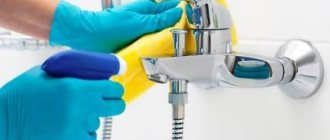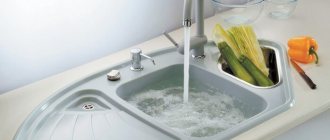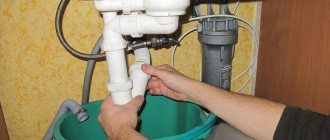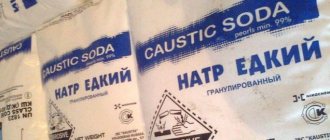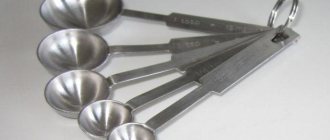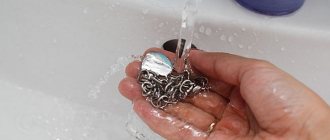Clogged drains are a common occurrence and are encountered regularly. You can eliminate it yourself, without resorting to the services of specialists. There are many ways to clean drains. One of them is the use of hydrochloric acid. The product is aggressive, but effective. Let's consider all the nuances of application and draw a conclusion about the advisability of using this chemical compound.
ATTENTION! A unique, highly effective product has been developed for cleaning sewer pipes, eliminating any blockages. The product is a concentrated mixture of enzymes that easily break down and process fat accumulations and any deposits of organic origin. One package of Saniclean will last you a whole year! Read more"
Hydrochloric acid for sewer cleaning
Hydrochloric acid is a homogeneous, colorless liquid with a pungent odor. It is a very caustic substance that reacts with most metals. Thanks to these properties, the material is widely used not only in industry, but also in everyday life.
The reagent is included in various means for getting rid of sewer blockages, but it can be used for this purpose independently, after diluting it with water in the required proportions.
The use of an acid solution in the home is not limited to this: the material is used to clean plumbing fixtures from rust and limescale, remove stubborn stains from fabrics, and even to remove scale from a kettle.
Precautionary measures
Since the reagent has a strong corrosive ability and releases toxic fumes when interacting with air, it is very important to use protective equipment when working with it.
When contacted with the skin and mucous membranes, the material causes chemical burns, and with prolonged exposure to an HCl atmosphere, tooth decay occurs, catarrh of the respiratory tract develops, and ulceration of the nasal mucosa occurs.
For protection purposes, it is necessary to use a gas mask, a rubberized apron, goggles and rubber gloves. Carry out work only in well-ventilated areas. If the reagent gets on your skin or mucous membranes, rinse the affected area with plenty of running water and seek medical help.
How to get rid of blockages?
For tough and targeted cleaning of sewers from organic deposits (fats, food debris, hair, detergents, etc.), dilute hydrochloric acid should be used. This method is not suitable for steel, iron and plastic pipes, since the connection can lead to corrosion and even the formation of through holes.
Before starting the procedure, you need to close the drain holes in other plumbing fixtures and ensure air flow into the room. This step is necessary, since during operation the acid will begin to actively produce toxic gases.
It is recommended to dilute the composition with water until a concentration of 3-10% is reached, then pour directly into the sewer and leave for 1-2 hours. Then you need to rinse the pipes with plenty of water and repeat the procedure if necessary.
Important point! The reagent should not be mixed with other drain cleaners, especially those based on alkalis. Otherwise, the reaction of these connections will cause severe damage to the pipes.
Precautions when using chemical pipe cleaners
Any household chemical can cause harm to humans, especially if it is made with powerful reagents, such as pipe cleaners.
Before use, it is best to ask everyone to leave the house, because the smell of chemicals is very strong. Open all the windows in the apartment in advance and leave them in this position for several hours after cleaning the pipe, and best of all until the smell completely disappears.
Be sure to put on gloves and a respirator mask before starting work. Make sure that particles of the product do not get on clothes, skin, or mucous membranes. In case of contact, rinse immediately with running water.
Other uses of acid in everyday life
An acid composition can easily clean faience plumbing from limescale and rust, remove urinary stone and other contaminants. For greater effect, an inhibitor (for example, methenamine) is added to the product, which slows down the chemical reaction.
The procedure is carried out as follows: the acid is diluted with water until a 5% concentration is reached and an inhibitor is added at the rate of 0.5 g per 1 liter of liquid. The resulting composition is treated with the surface and left for 30-40 minutes (depending on the degree of contamination), after which it is washed with water.
A weak acid solution is also used to remove berry stains, ink or rust from fabrics. To do this, the material is soaked in the composition for some time, after which it is thoroughly rinsed and washed as usual.
Descaling a kettle
For this purpose, use a 3-5% solution of hydrochloric acid, which is poured into a kettle and heated to 60-80 ° C for 1-2 hours or until scale deposits disintegrate. After this, the scale becomes loose and can be easily removed with a wooden spatula.
The effectiveness of the method is due to the fact that the reagent reacts with magnesium and calcium carbonates and converts them into soluble salts. The carbon dioxide released during this process destroys the scale layer and makes it loose. After removing salt deposits, wash the dishes thoroughly with clean water.
Important point! This method is not suitable for descaling enamel or aluminum kettles with chips and cracks: this will lead to corrosion of the metal and severe damage to it.
Blockage in pipes: reasons
Cast iron sewer pipes are still found in older houses. This material is susceptible to corrosion, the inner walls become uneven over time, and a coating of rust forms on them. Most often, blockages form in such potentially dangerous places: the section from the outlet of the kitchen sink to the outlet in the bathroom.
If the apartment has plastic pipes, the cause of the blockage may be improper installation, that is, failure to observe the slope of the pipe towards the riser. This leads to the formation of plaque inside the pipes. One of the most common causes of clogged pipes is grease. Over time, it settles on the inner surface of the pipes, retaining small debris, food debris, etc. such sediment gradually compacts and reduces the throughput of the pipe.
The cause of clogged pipes may be improper installation or failure to comply with the pipe slope. A foreign object may enter the system; as a result of long-term operation, a thick coating forms on the inner walls of the pipes. Pipes also become clogged due to improper or lack of proper maintenance.
There are several ways to clear clogged pipes at home, using folk remedies, chemicals and mechanical devices. If water begins to drain slowly through the drain hole, an unpleasant smell appears in the kitchen or bathroom, or water rises under the drain grates of the sewer when the pressure is turned on, you need to remove the blockage.
Most often, pipes become clogged in the summer-autumn period, which is associated with much greater water consumption and an increase in the amount of garbage entering the sewer system. You should be especially careful during the period when harvesting for the winter is being done and it is advisable to have on hand something that can be used to clean the pipes.
Types of sewer pipe cleaning products
Based on their chemical composition, products are divided into alkaline and acidic. Acidic ones dissolve hair well, so they are best used in bathrooms and showers. Alkalis work better with fats and are mainly used for cleaning kitchen drains, even when heavily clogged.
Alkalis
The main component of alkaline liquids is caustic soda. This substance is extremely aggressive, so when working with it you need to use gloves, a face mask and goggles.
Pros of use:
- Copes well with old clogs of organic origin.
- It will help remove brown deposits from cast iron and metal frying pans and pots, except for products made of aluminum or coated with Teflon.
- It works even after flushing the pipes, so after using it to break through the sewer, the effect lasts a long time.
- Works fast. It only takes about 15 minutes for the alkali to dissolve the plug and completely clean the drain.
- Suitable for cast iron pipes.
- It is used in local sewerage to remove distant blockages. To do this, the substance is diluted with water and poured into the system. After this, you should not use the sewer for a couple of hours to allow the chemicals to do their work.
Minuses:
- Caustic can corrode damaged pipes, so it should be used with caution.
- Can gradually destroy the enamel on a bathtub or sink. It is advisable not to allow the substance to come into contact with visible parts of the plumbing.
- In general wastewater it causes the death of bacteria if an aerobic method of eliminating odor and processing organic matter is used in the sewer.
- Difficult to buy in store. You can order the powder on websites that sell products for soap making at home.
- Requires adherence to exact proportions when diluting with cold water.
- The substance is flammable and explosive - must be kept out of the reach of children.
In addition to sewage, caustic is used for washing and bleaching cotton and linen items, in gardening against fungal diseases of plants, for making soap and other purposes.
When dissolved in water, alkali generates heat; some materials can withstand short-term temperature increases of up to 100 degrees, so before use you need to check what material the pipes are made of.
Acidic products
Acid-based products are commercially available that can be used on all types of pipes. But they may be weak and will not clear the blockage. On forums you can find advice from “practitioners” who write that hydrochloric acid helps a lot. This is not entirely true:
- If PVC pipes are installed in the apartment, concentrated hydrochloric acid will corrode them within 30 minutes.
- In apartment buildings, the riser and main line are most likely made of cast iron, in which acid can make holes and the entire system will have to be replaced.
- Acid can cause a chemical burn if you do not use protective equipment. The fumes from the substance are poisonous and can cause respiratory problems.
First you need to try diluting hydrochloric acid to 5 - 10% concentration and pouring it into the sewer. A 35% substance can dissolve plastic and cause an accident throughout the house - pressure increases in a clogged pipe and it heats up. The same effect is achieved by using sulfuric acid.
At home, acetic, phosphoric, oxalic, and sulfamic acids are used. The problem is that besides acetic acid or essence, you can rarely find anything else from the above in stores.
Blockages can have different origins: calcium deposits, silicate deposits, metal oxides. To remove them with acid, you need to call a qualified technician. Knowing the material used to make pipes, he will recommend a safe but effective method.
How to clear clogged pipes at home: in the bathroom
How to clear clogged pipes in the bathroom at home using a plunger? The bathroom, unlike the sink, is equipped with a safety drain hole. It must be closed before cleaning. Using a plunger, a hydraulic shock is generated, which displaces the accumulation of dirt down the pipe from the narrow place of the drain, where a blockage most often forms. First, you need to fill the bath with enough water to cover the cup of the plunger. Place the plunger over the drain hole, press it tightly to the hole and sharply press the handle 3-4 times and sharply remove the plunger from the water. Repeat if necessary until water begins to flow freely.
You can clean the bathtub with a brush, for which you insert it into the sewer hole and use sudden movements to break through the clog that has formed. If necessary, you can attach a brush to a flexible rod to extend the structure and reach the blockage at great depths.
If a plumbing cable is used for cleaning, the siphon is turned out and the cable is inserted into the drain hole as deeply as possible. At the same time, it is rotated in both directions. Screwing into the pipe, the cable clears all blockages, the debris moves down the drain and is washed out. At the end of cleaning, all elements of the drain channel are washed and the siphon is cleaned.
If you don’t have wire or cable on hand, you can take an electric drill or screwdriver, which can also effectively help deal with the blockage.
Now let’s look at how to clear clogged pipes at home using traditional methods safely and effectively. Baking soda is great for this purpose. This is the cheapest and easiest method that any housewife can use without waiting for the help of a plumber.
You need to take soda and vinegar in equal proportions, for example, one glass each. Soda is poured into the drain hole and then vinegar is poured on top. The hole is closed with a stopper and left in this state for 2-3 hours, after which the pipe is washed with hot water. This method of clearing blockages is completely safe for pipes. It can be used not only to remove existing blockages, but also for prevention.
Let's look at a few more solutions made from soda that will help get rid of the blockage. To do this, take about 150 g of soda and heat it in a cast iron frying pan for about 15 minutes. After it has cooled completely, dilute it with a glass of water and stir thoroughly. This composition can be compared in effectiveness with the well-known store-bought chemical “Mole”.
Another safe way to clean your drains is using regular lemon. To do this, take a few lemons and squeeze them directly into the drain hole. Let sit without opening the water for at least an hour. If you don't have lemons, you can use half a cup of lemon juice concentrate. This method is also quite effective.
If a blockage of grease has formed in the sink, you can prepare a strong salt solution. It is poured directly into the drain hole and they begin to clean the drain with a plunger. To ensure a better fit of the plunger, its edges can be lubricated with an inexpensive cream.
A simple blockage in the drain can be removed with a powerful vacuum cleaner using its blowing function.
Are there alternatives to acid drain cleaning?
There is no point in tempting fate and risking the destruction of communications solely for the sake of cleaning them from the inside. A safer and more effective way would be to clean the sewerage system in Khabarovsk using a mechanical method - using a cable or a hydrodynamic installation.
Choosing a cable will eliminate almost any blockage and partially remove dirt from the pipe walls. When performing hydrodynamic cleaning, it will be possible to bring the pipeline to ideal condition. In both cases, the procedure will not require the use of dangerous chemicals, and therefore will help achieve the goal without any risk.
How to clear clogged pipes at home: in the kitchen
Let's talk about how to clear clogged pipes in the kitchen at home. First you need to understand how the siphon in the sink works, since in many cases you can limit yourself to just cleaning it.
The most common are bottle siphons, the diameter of which is 32 or 40 mm. The smaller the diameter of the drain hole, the faster it clogs. The design of siphons includes a removable part resembling the bottom of a bottle. Removing a blockage in the sink with such a siphon will not be difficult. No special tools are needed to unscrew the removable part.
So, unscrew and remove the sump, first placing a bowl or bucket under it so that the remaining water does not spill onto the floor. Next, using a wire with a hook at the end, we clean the siphon.
Other types of siphons can also be used in sinks. Pipe - made in the form of a curved tube. Quite often there are corrugated siphons, which are easy to bend and can be installed in non-standard conditions. Siphons with overflow are installed in sinks with a special hole to drain excess water. If you are connecting a dishwasher or washing machine, double or triple siphons are used. There are hidden siphons that are installed in a box.
To prevent your sink from clogging, you can place a plastic mesh over the drain hole. You can install a garbage grinder that shreds all the waste that gets into the sink, and then the small debris is washed down the drain. A garbage grinder will eliminate the need to frequently clean pipes; it can easily handle not only soft waste, but even grinds bones and operates silently. It does not take up much space and does not require special care; a simple wash with cold water is sufficient.
Tip 1: How to clean plastic pipes
Pour a little hydrochloric acid or alkaline products like “Tiret” or “Mole” into the drain. They eat away organic debris that clogs pipes . without damaging the plastic. But, just in case, read the instructions before use. If you do not get the desired effect from the remedy that you usually use in a similar situation, use another one. Perhaps it will do a better job of dealing with what is currently clogged in the pipes .
Pour 3-4 tablespoons of baking soda or laundry detergent into the drain and fill it with ½ cup of vinegar. Close the hole. Remove the sprayer from the shower and insert the hose into the hole. Plug the loose areas with a rag and, turning on the hot water at full pressure, rinse the drain.
Try pumping the drain with a plunger. After closing the hole with a stopper, fill the bathtub or sink with water so that it hides the rubber element of the plunger. Close the overflow hole tightly with a rag, remove the plug and cover the hole with a plunger. Press it firmly and jerk it upward. Lift the plunger to allow water into the pipe and pump a few more times.
Unscrew the plastic drain, clear the siphon and folds of debris. Insert the cleaning cable into the pipe and lower it to the depth with a rotating motion. Move it back and forth for a few minutes. Dirt will wrap around the cable, and plastic debris will be washed away with water.
Tip 2: How to clean pipes
Pipe blockages are a very common occurrence, which is why it is important to always be able to properly clean the pipes when necessary. The optimal solution if there is a blockage is to cooperate with specialized companies that are able to eliminate even the most complex blockage through the use of modern equipment.
However, if you need to clear a clogged water supply at your dacha, simple everyday methods will come in handy.
1. The easiest and fastest option is to use a plunger. This method is effective only if there is a small blockage; if it is a minor problem, you can forget about the blockage in just a few minutes. If you don’t have a plunger at hand, you can use a cardboard bag instead, for example, the kind that is used as packaging for dairy products. The edge of such a bag is cut off and the cut part is inserted into the drain hole. then press sharply on the bag with the palm of your hand.
2. If the blockage is large enough and superficial methods of removing it are ineffective, specialized chemical compounds can be used. They are not capable of damaging even polyethylene pipes. so you can safely use them at home. and at the dacha. However, if you don’t have a pipe cleaner at hand, you can use its household equivalent: pour regular baking soda down the drain, and then pour in a little vinegar (no more than 100 ml). Due to the reaction that occurs as a result of the interaction of soda and vinegar, even severe blockages in pipes disappear. However, when using this method, you should follow safety regulations.
3. If it is necessary to clean pipes that are made of metal. It is acceptable to use a cable. It can be used in other types of pipes, however, during unprofessional use, it can damage the surface of a polyethylene pipe or a joint made with fittings.
Blockages can occur completely unexpectedly, since they are often caused by non-foreign objects that have gotten into the pipe. and poor water quality, as well as food debris that gets into the drain. In order to deal with blockages in a timely manner, it is always necessary to have chemicals in your arsenal. as well as a plunger, which, despite the presence of various innovations, still remains the most effective means of combating blockages.
How to make a sandbox for children with your own hands
First you need to decide on the size of the sandbox and the construction site. If there are several in your family.
Also viewed with this article
Forgot your password?
Not registered yet?
Requirements for means for dissolving blockages
Any composition for cleaning sewers is subject to a certain set of requirements. If an industrially produced product does not comply with them, it will not be allowed for sale. There are no such strict restrictions for a homemade solution, but it is advisable not to ignore them. We will use these criteria when assessing the effectiveness of the formulations being analyzed.
Here are the requirements for means for dissolving blockages in sewer pipes:
- Efficiency. The ideal composition should remove blockages anywhere in the sewer system. Real formulations rarely achieve such effectiveness, having certain limits of applicability. Expanding the scope of application requires the introduction of potent substances into the composition, which is not always possible or justified.
- Health safety. It is advisable that the product does not burn the skin of the hands and mucous membranes. Unfortunately, this requirement directly contradicts efficiency. Therefore, it is recommended to wear protective gloves when using many recipes.
- Safety for the materials from which the pipes are made. This criterion sounds quite strict: the composition used should not destroy the cast iron and polymers from which the sewer system pipes are made.
- Availability and low price. The rarer the components are and the more expensive they are, the worse the product will meet this effectiveness criterion. It is for this indicator that homemade compositions often outperform gels, powders and solutions made in a factory.
- Easy to use. The composition should not require long exposure or use according to a complex algorithm. In addition, an ideal product should “forgive errors” when used, i.e., remain effective even if the instructions are not strictly followed.
We recommend: Why cook starch paste and how to do it correctly? 3 proven recipes
Having decided on the principle of operation of homemade pipe cleaning compounds and formulated criteria for assessing their effectiveness, let’s move on to analyzing methods of dealing with blockages that have stood the test of time.
How can you clean sewer pipes at home?
The question of how to clean sewer pipes at home often arises among both residents of high-rise buildings and owners of private houses. It is not always possible to call professionals for help; often you urgently need to remove the blockage in the sink, in such cases you have to do this work yourself. Any home handyman can do such a task as cleaning the sewer with his own hands, he just needs to know the specifics of performing the specified work.
A little about the causes of blockages
Most often, there is a need to get rid of a clog in the sink, which occurs at the outlet from the sink or bathtub to the riser, since this is where dirt, grease and food debris accumulate, which interfere with the movement of drains. It may be necessary to clean the sewer in the area from the toilet to the riser; the area between the toilet and the bathtub gets clogged much less often.
How often sewer pipes will be cleaned in a private house or apartment will depend on how you operate the sewer system at home. Please note that the use of modern detergents that contain PAV leads to faster clogging of the drain system, they no longer drain well and the sewer needs to be cleaned or flushed.
Causes of blockages
Over time, settle : grease, food, detergents, hair, animal hair, and so on. If the drains are not cleaned in a timely manner, dirt can completely block the pipe opening. All types of pipes are susceptible to blockages: cast iron, plastic, metal. Most often, blockages occur under the sink in the kitchen, a little less often in the bathroom, and it is very rare that the toilet drain becomes clogged (usually, due to carelessness, rags, hygiene bags, and diapers can get into it).
If the toilet sewer pipes have completely stopped flowing water, you will have to call a specialist, since it is unlikely that you will be able to clear such complex blockages on your own. All other blockages can be cleared yourself.
Chemical and mechanical sewer cleaning
Even if you use the sewer system correctly, after a while you may still need to clean the sewer pipes; every home craftsman should be able to do this with his own hands.
Chemical cleaning should be carried out using personal protective equipment; removing blockages in this way should be done while wearing gloves and safety glasses. One of the modern remedies is Pothan, but there are other effective remedies.
The chemical for cleaning sewer pipes can be acidic or alkaline, pay attention to this, as they cannot be mixed. Both pipe cleaners, depending on their condition, are poured or poured into the sewer, where they should remain for 10-20 minutes, after which, to remove the pipe cleaner, they are washed off with 20-40 liters of water.
“Pothan” is a highly effective means for cleaning sewer pipes, but it is not always possible to clear a blockage in a kitchen or bathroom sink using it alone; mechanical cleaning of the system is often required.
Although mechanical cleaning requires more time and effort, it is more effective, and sometimes the only way to deal with blockages. The work is carried out using a special cable that must be rotated. To make this easier, there is a handle at one end. One end is inserted into the drain hole of the sink or bathtub, and by rotating it, the blockage is cleared.
If your kitchen sink is slightly clogged, you can clear the clog using a plunger. It is enough to place it against the drain hole and make several vertical movements. To make the process more effective, after this you need to drain several buckets of water, and it will help remove the remaining dirt.
Remedies
The most effective methods include mechanical cleaning. It is simple and easy to do yourself. A plumbing cable is used, which is inserted into the pipe and pushed inside with rotational movements.
When contact with the blockage occurs, the cable tip destroys the plug. After this, the internal cavity of the pipelines is washed with a strong stream of water.
There is hydrodynamic cleaning. It is produced using special equipment. The essence of the method is to immerse a thin hose with a special tip, from which a stream of water shoots out under strong pressure. The effectiveness of this method is higher than that of alternative types of cleaning.
The use of chemicals, as a rule, is carried out only to clean the internal areas of the system. There are many formulations on sale that contain alkaline or acidic components. Sometimes drain cleaning with hydrochloric acid is used. This is an extremely dubious and dangerous method that can do more harm than good.
Using regular salt and soda
If there are no means at hand, salt is often used to clean the drain. It is poured generously into the drain hole and left for some time. Salt eats away fat deposits and makes them loose. After some time, the siphon is washed with a strong stream of water, removing organic particles.
To enhance the effect, make a mixture of soda and salt. The proportions vary, but the effect is usually the same. Please note that regular baking soda is not suitable. You need a caustic that can effectively interact with fats. In addition, caustic soda can dissolve more complex blockages. For example, hair that does not interact well with most chemicals.
However, this method is only suitable for blockages located near the drain. If the problem section of the pipe is further away, more radical remedies are needed.
Using the hydrodynamic method
To carry out this method, you need special equipment or a mini-wash; they create high water pressure, and this allows you to effectively clean clogged sinks in the bathroom or kitchen, and the diameter of the pipes can be from 50 to 300 mm.
This method is usually used in industrial enterprises, but now compact equipment has appeared that can be used to effectively clear clogged sinks in the bathroom or kitchen at home.
You can also clear a blockage in a pipe using a spiral cleaning machine; in this case, spirals of different diameters and shapes are used. This method is reminiscent of mechanical methods for cleaning sewer pipes using a cable, but in this case the spiral does not rotate manually, like a cable, but is done by a special machine. It is not advisable to purchase such equipment for home use, since it is quite expensive, so it is usually used only by professionals.
What is the best chemical for drain cleaning?
It is quite difficult to answer this question, because each drug is used only for certain purposes. We will consider all funds by category.
Among liquid chemicals for cleaning pipes, the best is the active gel from Mister Muscle . By the way, it didn’t have much competition among the products we listed. The only downside to Mister Muscle is the price. The Mole company produces cheaper products, but they act more slowly. Among the granules, the best is undoubtedly the product from the Pothan brand . It is considered the heavy artillery when removing complex blockages.
Regardless of which product is worse and which is better, they all have one thing in common - these are safety rules for use.
Using Home Remedies
Very often, when deciding how to clean a sewer at home, folk remedies are used. Before starting this work, it is necessary to check all existing drains. This will help you decide whether there is a local blockage or the main riser is clogged. After this, you will understand whether you need to clean the pipes only in the bathroom or kitchen, or whether you need to clean the main drain pipe.
The easiest way when a blockage occurs is to use boiling water; it helps remove fatty deposits and is often enough to clear the blockage.
You can effectively combat this problem with baking soda and vinegar. In this case, first remove and clean the siphon, and if this does not help, then approximately 200 grams of ordinary soda are poured into the pipe, after which 300-400 grams of vinegar are poured into it. As a result of the chemical reaction of these two substances, grease blockages are effectively removed and the normal outflow of sewer water is restored. To prevent the foam that forms from the interaction of soda and vinegar from coming out, the hole must be closed.
Instead of soda, you can use Alka-Seltzer tablets, throw 2-3 tablets into the drain, then pour in a glass of vinegar and after a few minutes rinse everything with water. This method allows you to get rid of not only the blockage, but also the unpleasant odor.
You can use salt and soda; for this, 150 grams of salt and 300 grams of soda are dissolved with water and poured into the drain. This mixture should remain there for 15-20 minutes, after which a plunger is used, and then everything is rinsed well with water.
In order for you to have the question of how to break through a blockage in the bathroom or kitchen as little as possible, it is recommended to rinse the riser against blockages with boiling water once a month, and once every two months, or better yet at shorter intervals, use any pipe cleaner , even if you think you don’t need to do this yet.
Baking soda is an effective assistant in the fight against blockages
Sodium bicarbonate, or baking soda, is widely used in cooking as a leavening agent for dough. When in contact with acids, this substance produces a lot of foam. Baking soda has an alkaline reaction, which allows it to effectively fight grease and dirt. Many housewives use it for cleaning dishes, stoves, cleaning and other operations.
In the fight against blockages, the ability of soda to saponify fats due to the alkaline hydrolysis reaction is used. There are several ways to implement this reaction, which should be considered in more detail.
Compositions based on soda and vinegar
The interaction of soda with acetic acid is accompanied by the rapid release of carbon dioxide. The gas pressure forces the foam into the plug, where the soda destroys deeper and deeper layers. All this quite effectively destroys the blockage, which makes it possible to cope even with old fatty deposits.
When using acetic acid, do not forget about safety precautions. The vapors of this volatile substance can cause severe burns to the mucous membranes. Therefore, before starting work, open the window and ensure the room is ventilated. Also, find a plug in advance that can reliably block the drain hole.
Baking soda and vinegar are used in several ways to clean pipes:
- Half a pack of soda is poured into the pipe, and then 100 ml of vinegar is poured into the drain. The hole must be immediately plugged with a plug. Firstly, this will not allow caustic vapors to penetrate into the room, and secondly, it will not allow a loss of gas pressure, directing it completely towards destroying the blockage. When the reaction stops (this can be seen by the cessation of hissing; it usually takes about half an hour), the drain is washed with hot water. After 2–3 liters of water pass through the pipe, the blockage will be completely destroyed and removed from the system.
- Vinegar and soda (100 ml of acid and 100 g of powder) are mixed in a glass or clay container. After foam appears, the mixture is immediately sent to the drain hole, which is then closed with a stopper. Rinse the pipe after an hour and a half; this time is usually enough to dissolve fatty deposits.
Soda can be replaced with Alka-Seltzer effervescent tablets. 3-4 tablets thrown into the drain and filled with a glass of vinegar are enough to destroy the blockage and get rid of unpleasant odors from the drain hole.
Destroying blockages with a mixture of baking soda and vinegar can be considered an effective and inexpensive way to solve the problem. Its only drawback is the risk of burns to the mucous membranes due to acetic acid vapor. To reduce the danger to a minimum, follow technology and do not neglect safety precautions.
We recommend: Laundry sheets - newfangled nonsense or a really good product?
A mixture of soda and table salt
Coarse table salt has a good abrasive effect. It increases the effectiveness of using soda in combating blockages in the sewer system. In practice, these substances are used as follows:
- Soda and coarse salt in a ratio of approximately 2:3 (200 g of soda and 350 g of salt) are poured into the drain. Everything is filled with hot water (0.3–0.5 l). Then you need to wait 20 minutes. During this time, the soda will chemically dissolve the fat. To remove the blockage, the drain is thoroughly flushed with a large volume of hot water. To enhance the effect, repeat the procedure 2-3 times or use a plunger.
- Salt and soda in equal quantities (200 g each) are poured into the sink drain hole and 10 ml of acetic acid is poured. Since the reaction produces caustic fumes, the drain must be carefully plugged. After waiting for an hour, the drain is washed with hot water.
The use of table salt allows you to increase the effectiveness of using soda and eliminate the use of vinegar. However, this composition will only cope with small and relatively fresh plugs. If the deposits formed a long time ago, are thick, or are located far from the drain hole, the effectiveness of the method is reduced.

